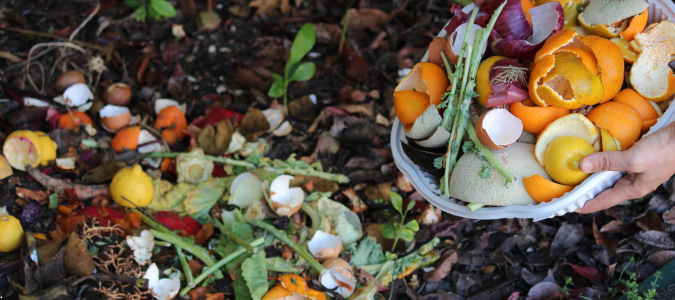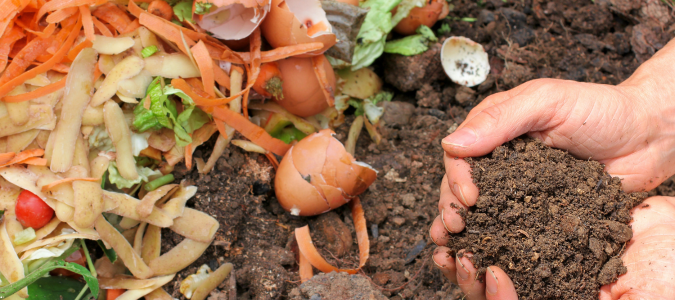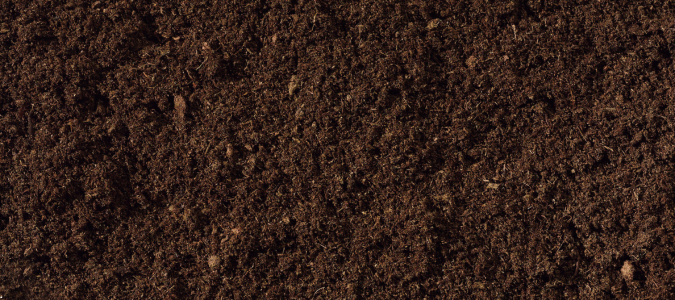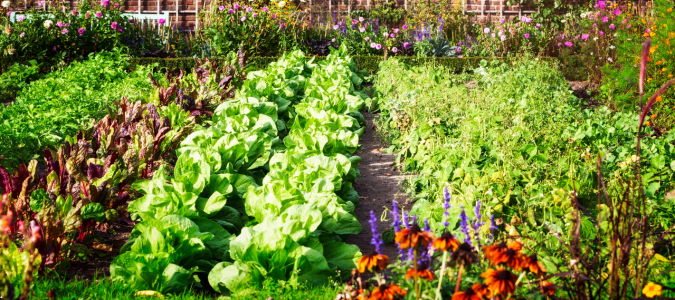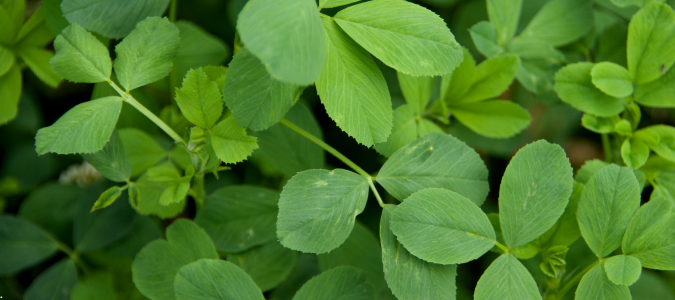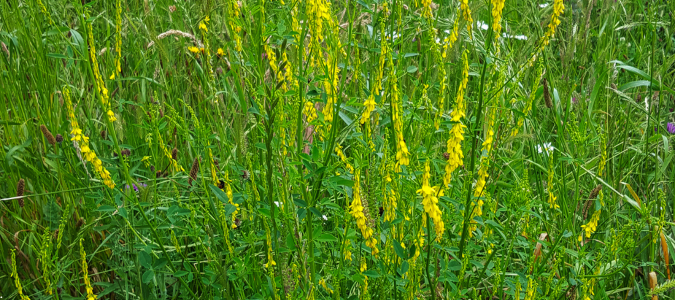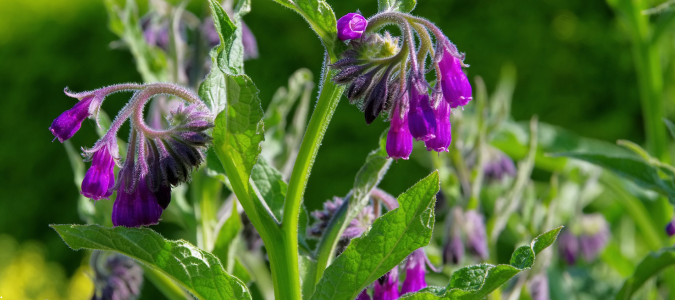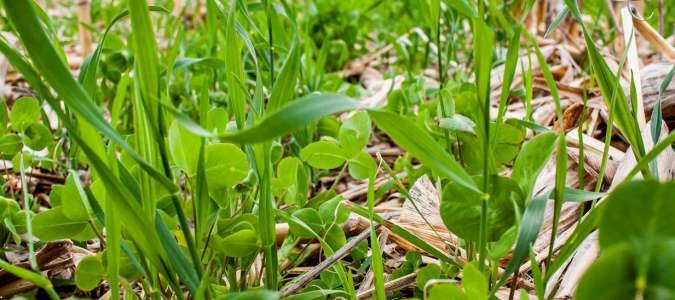What do grass clippings, dead leaves, coffee grounds and dinner scraps have in common? They can all be used to create or feed a compost pile. Then you can use the compost to help keep your trees, plants, fruit and vegetable garden and soil healthy.
Planting with compost is easy if you know the basics.
What is Compost?
First, let’s talk about what compost is and what it’s used for. At its most basic, compost is simply partially decomposed organic matter. In other words, plant and other material that is nutrient-rich because it’s in the process of breaking down. Over time, this mixture turns into fertile soil.
Gardeners use compost to add important nutrients and microbes to the soil, in order to build its structure and help plants thrive. Compost is often considered one of the most effective soil amendment options.
Compost Can Improve Your Soil
If you live in an area that has clay-like soil, for example, compost can improve your dirt by loosening it up. Looser soil improves aeration and drainage, which are critical for healthy plant growth. As a result, water drains more efficiently, and the soil becomes better suited for growing plants.
If your area has sandy soil, compost can improve it by helping it retain water better. If your garden struggles with drainage or dryness, compost is one of the best ways to improve soil.
Nutrients in Compost
Using the right kind and amount of compost can do a lot of good for your garden. It can improve plant health, cut down on pests and diseases and reduce how much fertilizer you need.
Manure-based compost usually has a lot of phosphorus, while plant-based compost, the kind you get by tossing kitchen scraps and yard waste into a pile, tends to have more nitrogen.
That’s a plus for most home gardens, since they don’t usually need as much phosphorus as manure provides. And extra nitrogen isn’t a big deal because it tends to wash away with rain or break down into the air.
Phosphorus, on the other hand, hangs around in the soil. Too much of it can build up over time, which can actually make your plants more prone to pests and disease.
Not sure where to start with compost? Lawn service pros can choose the right type and apply compost to boost lawn health.
Can I Plant in 100% Compost?
Most people see brown matter on the ground outside and think it’s dirt, no matter what it actually is composed of. Compost isn’t just dirt in disguise, it has a different makeup and purpose, and it can’t always be used as a soil substitute. Certain types and compositions of compost can be appropriate for planting without soil, but you have to check the nutrient composition and consider the particular needs of what you intend to plant.
In general, compost is a beneficial addition to most types of soil, whether your goal is to grow vegetables, flowers or other ornamental plants. However, the compost should only be a small proportion of the “dirt” you’re planting in.
With compost, a little goes a long way. Using too much compost may lead to nutrient overload, poor drainage or excessive salt buildup in the soil.
Using homemade compost is best for most home gardening needs. It can be helpful to know how much compost you need. A general recommendation is to spread an inch or two per year on your garden beds, or up to three inches on a vegetable plot. Apply compost in the early spring or fall for the best results, when the soil is moist and plants are ready to grow.
Can I Use Compost Instead Of Soil?
It’s only possible in a few scenarios to use compost instead of soil for planting. It’s generally not advised to do this.
One reason that pure compost often isn’t conducive to growing plants is that it gets too hot internally, since the organic matter it contains breaks down over time. Any plant that grows well in compost is going to be one that tolerates heat well, doesn’t grow too tall and thrives in well-draining soil.
If you’re going to use compost instead of soil, you should also make sure to use only fully processed compost. It should be black and crumbly with a rich, earthy scent. Only mature compost is suitable for planting, since immature material can harm plants that are more sensitive.
Compost that contains identifiable food scraps or that has an acidic smell to it isn’t fully processed yet, and should not be used for planting.
Not sure if what compost is best used for and when it’s ready? Lawn service experts can apply it at the right time.
Can You Grow Vegetables In Pure Compost?
Generally, growing vegetables in pure compost isn’t a good idea. Most plants need more structure, water retention and nutrients than compost alone can provide. There are certain crops, however, that can do well when planted in pure compost.
Tomatoes, pumpkins and squash are examples of crops that can do well growing in pure compost. Squash plants are more sprawling than tall, growing close to the ground along vines, and need well-draining soil. Both of these factors make them better suited for growing in pure compost than many other crop varieties. If you decide to grow pumpkins, squash or other crops in this way, be sure to water often, since pure compost can dry out quickly.
Growing Tomatoes In Compost: Can It Work?
Compost is typically a better addition to soil than an alternative to it, but there can be exceptions.
Tomatoes are one crop that have been known to grow well in pure compost. Many home gardeners have reported volunteer tomato plants that sprouted out of their compost piles after tomatoes with seeds were tossed into the pile. Instead of simply becoming part of the compost, the seeds germinated and grew into plants.
Growing tomatoes in compost on purpose may not be a good idea. Many varieties of tomato plants grow to be quite tall, and they need external support even in regular soil.
Tomatoes grown in pure compost are almost certain to need stakes, cages or some other type of scaffolding since compost has a crumbly consistency compared to the density of soil. Plants that grow tall or develop deep-reaching root structures aren’t well suited for compost-only planting. They’re more likely to fall over as they mature.
Planting Compost Crops
Certain plants make great “compost crops”, plants a gardener grows specifically to help build a nutrient-dense compost pile. This organic gardening method is often called “biodynamic gardening.” It focuses on creating high-quality compost from the start.
If you want to try this method, you can devote any portion of your garden to compost crops that make sense for your space and gardening needs. Here are some examples of good compost crops:
- Alfalfa and red clover
- Yellow clover
- Comfrey and borage
- Winter rye
Let’s dive into each of these a bit more.
Alfalfa and Red Clover
Alfalfa, pictured above, and red clover make good compost crops, since these plants will contribute minerals to your compost pile. You can plant either along the perimeter of your garden or in between rows of plants, and toss their clippings into your compost pile over time.
Yellow Clover
Yellow clover, pictured above, is another good option that will contribute nitrogen not only to your compost pile but also to the soil where its roots are growing. Just be sure to plant yellow clover out of the way, since it could over-shade other nearby plants as it grows.
Comfrey and Borage
Comfrey, pictured above, and borage are two good herbs for compost crops. They add zinc and phosphorus to the soil and your compost pile through clippings. They also attract butterflies and bees.
Winter Rye
If you’re looking for a good compost crop for overwintering your garden, try winter rye, pictured above. If you plant it in late fall or at the end of your garden’s harvesting season, it will protect the soil through the winter from cold, ice and snow, and add nutrients to the soil until spring, when it’s time to plant again.
At that point, you can mow down the rye and compost the clippings, or simply till the soil thoroughly to make it ready for your new crops. This creates the perfect foundation for transplanting or seeding new plants.
If you’re not sure which compost crops are right for your yard, a lawn service expert can help you choose and maintain plants that support long-term soil health.
ABC Can Help With All Your Lawn Service Needs
Want to add compost to your yard, but not sure how to get started? ABC Home & Commercial Services can help. Our lawn service experts will be happy to handle building and maintaining the garden of your dreams, so you can relax and enjoy its beauty.
